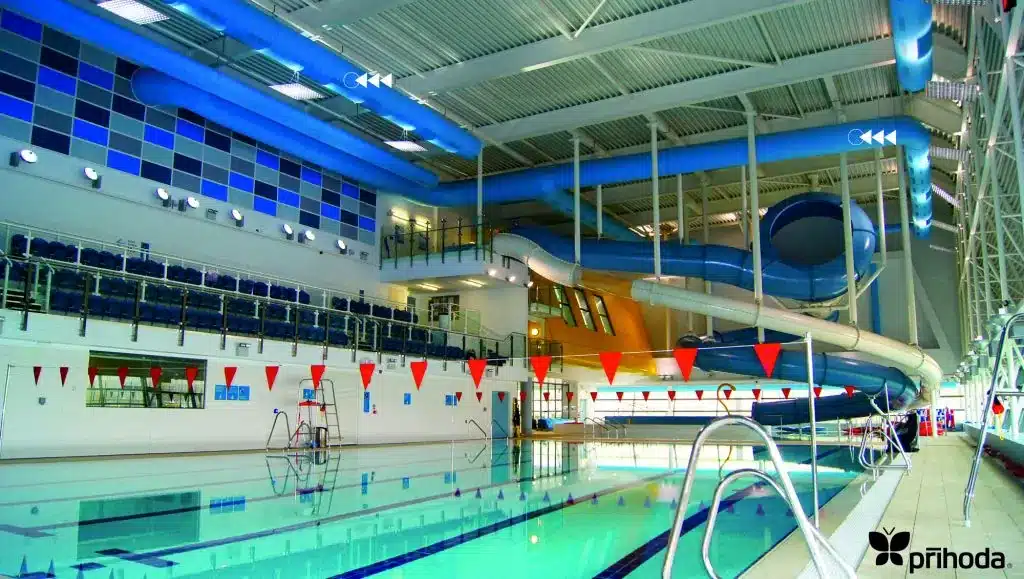How to Reduce Condensation in Swimming Pool Ventilation Systems


Indoor swimming pools present unique challenges when it comes to managing air quality and humidity. One of the most persistent issues in this environment is condensation. If left unchecked, condensation can lead to a range of problems including mould growth, structural damage and uncomfortable conditions for users. Fortunately, with the right approach to swimming pool ventilation, it’s possible to control humidity levels and reduce condensation effectively.
Why Does Condensation Occur in Indoor Pools?
Condensation happens when warm, humid air comes into contact with cooler surfaces, such as windows, walls or ceilings. Indoor pools produce a high level of moisture from evaporation, especially in heated water environments. Without a carefully designed indoor pool ventilation system, the moist air lingers and eventually turns into water droplets on surfaces.
This isn’t just a visual or comfort issue. Persistent condensation can corrode metal components, damage paintwork, and provide the perfect breeding ground for bacteria and mould. For public swimming pools or leisure facilities, this also raises hygiene and safety concerns.
The Role of Ventilation in Managing Condensation
An effective swimming pool ventilation system is the first line of defence against condensation. These systems are specifically designed to extract humid air and replace it with drier, conditioned air. In doing so, they help maintain optimal indoor air quality and keep surfaces free of moisture build-up.
Good indoor pool ventilation must be continuous and evenly distributed across the space. Stagnant air zones or poor airflow can cause localised condensation, particularly in corners, behind beams, or near glazing. To prevent this, it is essential to ensure that air supply and extraction are balanced, with careful attention paid to air movement near cold surfaces.
How to Reduce Condensation
Maintain consistent temperature and humidity control
Keeping the air temperature slightly higher than the water temperature helps slow down evaporation, which in turn reduces the amount of moisture in the air. In combination with proper dehumidification, this can significantly limit condensation.
Use appropriately designed air distribution systems
Fabric ducting systems are a great choice in swimming pool ventilation because they provide uniform air distribution. This reduces the risk of hot or cold spots and ensures that air flows across all surfaces, keeping them warm and dry.
Install adequate insulation
Walls, ceilings and especially windows in swimming pool buildings should be well insulated. This keeps surfaces warmer, which minimises the temperature difference between the air and the building fabric, helping to prevent condensation.
Ventilate glazing and cold surfaces directly
Targeting airflow over windows and external walls with warm, dry air is a proven method of reducing condensation. This is particularly important in winter, when cold outdoor temperatures can increase the likelihood of condensation forming on glass.
Ensure proper air extraction
Extracting air from areas where moisture builds up, such as directly above the pool or in changing rooms, removes humid air before it condenses. Positioning extraction points strategically is essential for overall system effectiveness.
Why Fabric Ducting is a The Right Choice for Swimming Pool Ventilation
Fabric ductwork offers distinct benefits for indoor pool ventilation. Unlike traditional metal ducts, fabric ducts distribute air evenly across their entire surface. This uniform distribution is ideal for high-humidity environments like swimming pools, where even air delivery helps prevent condensation pockets.
Moreover, fabric ducting resists corrosion and can be easily cleaned, making it a hygienic and durable choice for areas exposed to moisture. Its lightweight nature also allows for easier installation in retrofits or complex ceiling structures.
Effective swimming pool ventilation requires more than simply installing a dehumidifier or turning up the heating. It demands a thoughtful approach to airflow, temperature control and surface insulation. By using specialised indoor pool ventilation solutions like fabric ducting and designing with moisture management in mind, facilities can prevent condensation issues and create a healthier, more pleasant environment for pool users.
Looking for more information?
Our experts are on hand to answer any questions. Why not give us a call or drop us a message, We’ll work with you to find the right solution.
Contact us

